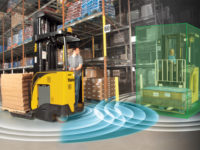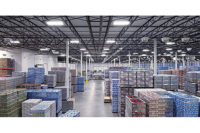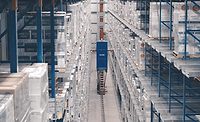Lift trucks innovate to meet SKU proliferation trends
Forklifts designed to help beverage companies with cost containment and productivity






Forklifts are reaching new heights of functionality. The demand for vehicles that are efficient, safe and have the flexibility to operate effectively in a host of environments is leading to the development of models with enhanced designs and features.
Elements such as GPS tracking systems, sustainable battery-powered motors, electronic reporting and speed control are becoming prevalent, and additional upgrades are likely as operators focus on two major purchase drivers: cost containment and productivity.
Meanwhile, the proliferation of SKUs in the beverage sector is generating a greater demand for — and resulting in the launch of — forklifts that are able to retrieve pallets that are stacked higher, enable workers to easily pick specific SKUs from pallets that hold a variety of products and move seamlessly in congested areas with narrower aisles.
In addition, beverage distributors are seeking forklifts with the capacity to handle large and heavy loads, are resistant to corrosion from liquid spills, and have the traction control to keep tires from slipping in a damp environment.
“Beverage distribution centers continue to deal with unprecedented SKU growth as well as growth in the diversity of retail channels they are serving,” says Shelley Bell, warehouse industry manager for Greenville, N.C.-based Yale Materials Handling Group. “Distribution center managers are challenged with efficiently managing this inventory and delivering it with speed and accuracy.”
Indeed, developing vehicles that enable customers to generate cost savings from productivity gains is a key focus of forklift suppliers realizing a solid return-on-investment is crucial for prospective buyers as investments in forklifts can be significant.
For instance, Perry Ardito, general manager for Mitsubishi Caterpillar Forklift America (MCFA) Inc.’s Jungheinrich Warehouse Products Group, a Houston-based forklift vendor, notes that the traditional counter balance forklift, in which the forks protrude from the front of machines, is often priced at $30,000-$35,000; order pickers, in which the operator rides in a cage welded to the fork carriage and hand selects individual items from pallets, are about $35,000-$40,000; reach trucks, in which the fork carriage can reach out into the racking to retrieve pallets and is able to rise to greater heights, are in the $40,000-$45,000 range; and turret trucks, which are designed to maneuver in very narrow aisles, often range from $85,000 to $110,000.
“Having vehicles that streamline the beverage operation is always a focus,” says Maria Schwieterman, senior market product manager for Crown Equipment Corp., New Bremen, Ohio. “More technology is being added to trucks for greater productivity, and that includes exploring alternative energy sources for better and longer lasting power.”
Battery-powered vehicles are becoming particularly prevalent as an emphasis by operators on sustainability and the passage of strict emissions standards has many beverage distributors looking to convert from forklifts with internal combustion engines, notes Cesar Jimenez, director of product planning for technical services and warranty, at Irvine, Calif.-based Toyota Material Handling U.S.A. Inc.
“Companies within the beverage distribution industry also are looking for high quality electric pallet trucks for their delivery trucks,” he states. “Having a reliable electric pallet truck allows a delivery driver to keep on schedule and eliminate costly downtime.”
Improvements to batteries, such as longer run times from a single charge, also are resulting in efficiencies and helping to streamline distribution center operating costs, Ardito states.
“We now can get forklifts operating for two shifts on a single battery charge and that was unheard of until two years ago,” he says, adding that faster charging batteries also are leading to a reduction in vehicle downtime.
Smaller-sized batteries with lower charger output requirements, meanwhile, are enabling users to save on initial battery and charger costs while reducing charging times. Such batteries that take up less space also enhance forklift maneuverability in confined areas by reducing the overall turning radius, suppliers note.
The composition of batteries also is evolving as more environmentally conscious operators seek such sustainable options as maintenance-free lithium-ion battery packs. Yale’s Bell notes that lithium-ion technology, unlike traditional lead acid batteries, does not corrode during short charging and extended storage and can last as much as five times longer, resulting in a reduction in forklift downtime and battery replacement expenses.
In addition, battery charging technology is becoming more efficient. Instead of having a charger go through a full cycle, which could take six or more hours, charging can occur in spurts throughout the day, such as when the forklift is idle during lunch breaks and between shifts.
“The battery can operate on 40-80 percent of capacity,” says Brian Markinson, director of North America sales for Marengo, Ill.-based UniCarriers Americas Corp., noting that operators do not have to wait until a battery is fully charged to run their forklifts.
Technologies that monitor forklift operations, also are becoming more prevalent. This includes wireless systems that connect to fleets and capture truck and operator data and lets users perform such functions as monitoring equipment status, scheduling service, checking battery and fuel usage and insuring only authorized individuals are using vehicles.
“The lift truck has an opportunity to be the hub of a lot of information,” Crown Equipment’s Schwieterman states. “Technology can accumulate data from any piece of machinery. The data, however, has to be transformed into something actionable. The next level of advancements will tie information together from different areas of the warehouse in a simple format that will help users make better operational decisions.”
Newer enhancements, such as the use of navigation technologies on forklifts, already are helping to cut time and expenses from the use of forklifts in distribution centers.
GPS, for instance, is able track the operation and location of lift trucks, which allows managers to monitor performance in real time and take steps to enhance safety and warehouse efficiencies, Yale’s Bell says.
The GPS data extracted from lift truck routes can provide insights about high-risk collision areas and route effectiveness. Metrics such as idle time and impacts enables companies to track the performance of individual drivers to help keep untrained personnel from operating equipment, improve driving behaviors and reduce equipment damage and repair costs.
Other tools include radio-frequency identification (RFID) readers that are placed under trucks and work with small capsule-sized transponders that are embedded in the floors of distribution centers. The technology enables system operators to monitor the location of each forklift and issue commands to vehicles based on their locations within warehouses. Commands include the need for speed reductions, warnings about height limitations and end of aisle notifications.
The technologies also can direct forklift operators to the location of specific pallets. An arrow on the vehicle display panel indicates the direction for the driver to travel, reducing the pick cycle time.
“There is about a 25 percent increase in productivity as the system determines what path to take,” MCFA’s Ardito says. “The process is quicker and uses less energy.”
Forklift designers, also are incorporating a myriad of safety features. They include vehicles that automatically switch into the neutral gear when the operator leaves the seat with the engine running, preventing the truck from potentially crushing the driver.
A recent innovation, UniCarriers Americas’ Markinson says, is the projection of blue dots on the floor 20 feet from the rear of the forklift to alert pedestrians that the vehicle is operating nearby.
In addition, audio alarms are becoming more sensitive to ambient noise in facilities. Alarms that sound when vehicles back up, for instance, can automatically become louder in noisier locations.
Some models also offer a forward tilt angle control feature that automatically overrides the operator’s manual control and limits forward tilt to decrease the likelihood of a forward tip-over or spilling a load, Toyota’s Jimenez says, adding that a rear tilt speed control feature will automatically govern the mast’s reverse tilt speed, thereby reducing the likelihood of a rearward tip-over or spills. The mast is the vertical assembly that does the work of raising, lowering and tilting the load.
“There is a constant evolution of products as buyers become more savvy about features that save them money or time,” Jimenez states. “Ergonomics will continue to be emphasized as the operator’s comfort plays a large role in productivity. Concern for the well-being of employees and the company’s bottom line will result in lift trucks being considered based on safety features and low operating costs.”
Pinpointing the optimal size of fleets, and subsequent user expenses, however, can be challenging. In some instances, companies can reduce overall costs by renting or leasing forklifts instead of purchasing them, particularly when greater seasonal business necessitates the temporary need for additional trucks.
“One of the biggest benefits to leasing is allowing customers to remain focused on their core business and not the forklift business,” Jimenez states. “When a customer leases they are able to turn in the asset before the maintenance cost begins to increase. Customers can customize the lease term to their operating hours so that they balance the cost to maintain the asset.”
Depending on the situation and terms of their contracts, operators might pay from $250 to $3,000 a month to rent a vehicle, MCFA’s Ardito says.
“It is better to rent for several months when usage peaks rather than to have a fleet of trucks sit idle because there is no use for them 70 percent of the year,” he states.
When deciding on whether to rent, lease or purchase, operators also have to take into account such issues as tax ramifications, cash flow and maintenance costs, UniCarriers Americas’ Markinson notes, adding that company accountants typically should deal with such considerations.
Forklifts are rapidly evolving with designs and technologies addressing such key user concerns as safety, productivity and sustainability. The ability of vehicles to operate effectively in beverage distribution centers where a proliferation of products is resulting in tighter aisles and pallets stacked higher also is leading to greater efficiencies. The issues are ongoing and are set to trigger further vehicle upgrades.
“The future will see a greater demand for speed, and technology must enable greater transparency of operations,” Yale’s Bell says.
Looking for a reprint of this article?
From high-res PDFs to custom plaques, order your copy today!









